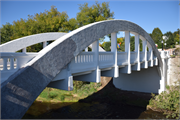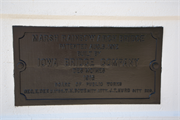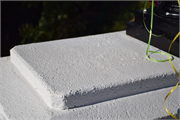| Additional Information: | A 'site file' exists for this property. It contains additional information such as correspondence, newspaper clippings, or historical information. It is a public record and may be viewed in person at the Wisconsin Historical Society, State Historic Preservation Office.
SEE DOT BRIDGE SURVEY. PLAQUE ON BRIDGE STATES "MARSH RAINBOW ARCH BRIDGE" PATENTED 8/6/1912. HAER WI-37. BRIDGE WAS CONSTRUCTED BY THE IOWA BRIDGE CO. ONLY KNOWN WISCONSIN EXAMPLE.
Concrete span in arch form with concrete rails, supports foundation. Constructed in the typical arch form of concrete bridges in which the roadway is suspended from the arch in 1916 at a cost of $13,950 by the Iowa Bridge Company. The Spring Street Bridge is a 93 foot single span arch with eight concrete vertical intermediate posts joined by concrete floor beams. The concrete balustrade is carried across the arches and over the abutments at each end where the original lamp posts remain intact.
Chippewa Falls boasts Wisconsin’s only Marsh Rainbow Arch Bridge, a patented reinforced-concrete span. Marsh, an engineer from North Lake, Wisconsin, developed the prototype in 1912, basing his invention on the metal bowstring arch, which his onetime employers, the King Bridge Company of Cleveland, had patented.
Concrete is more rigid than metal. But since bridges must bend with heavy loads, concrete alone cannot be used. If concrete is reinforced with iron or steel bars for elasticity, a bridge becomes both stable and flexible. Reinforced-concrete spans existed as early as the 1880s, but they used large quantities of iron and imitated traditional stone bridges in their design. Soon after 1900, European engineers experimented with slender ribs and flattened parabolic curves. Workers built these new bridges much as they would a metal truss bridge, assembling the steel-lattice frame on the ground, then placing it atop concrete piers. Finally, they poured concrete around the frame, a technique called “cast-in-place.”
The previous bridge over Duncan Creek washed out in the spring of 1916, so the city selected Marsh’s design for a new bridge and hired the Iowa Bridge Company to build it. The elegant rainbow arch has twin arches springing from a line 13 feet below the road deck, rising to their apexes 26 feet above the spring line. The arches taper in thickness from abutment to apex, adding a sense of grace. The bridge deck hangs from reinforced-concrete members that descend from the arches. Oval-pierced concrete railings enclose the sides of the 90-foot span. The original lampposts, with their acorn globes, still greet travelers at each end.
The concrete Spring St. Bridge is significant because of its uniqueness in the state and region. |
|---|





